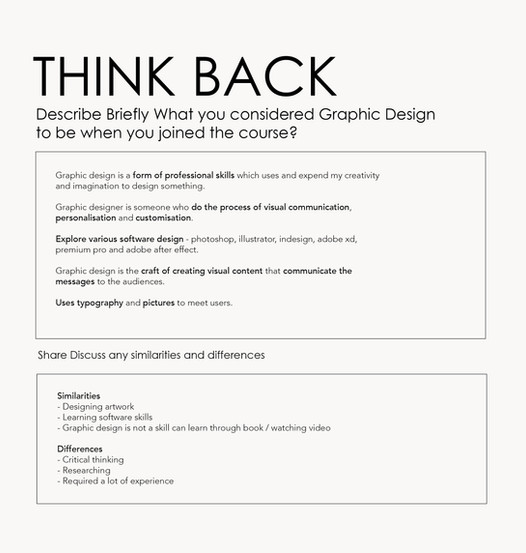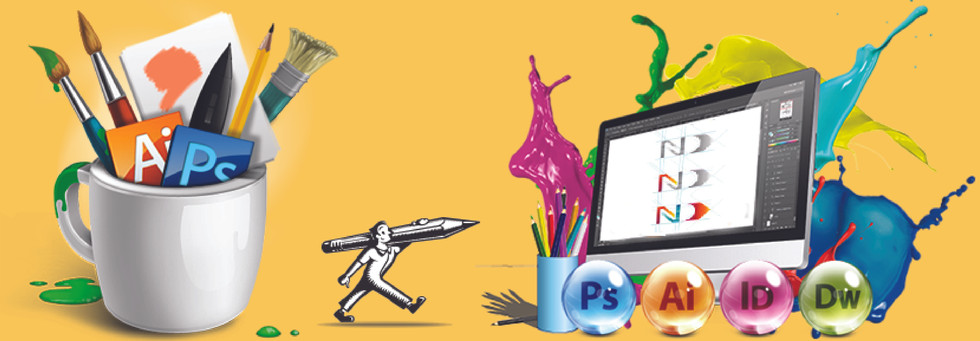Think Back Worksheet & GD Map (500 words)
- Kevin Tan

- May 25, 2020
- 5 min read
Updated: Jul 24, 2020
First and foremost, the first page of the think back worksheet reflects on what I have considered graphic design to be when I joined the course. Not only that, I needed to compare and discuss the similarities and differences of graphic design. Thus, it required me to think personally and reflects on my decision and thoughts towards the course.
Furthermore, I’ve begin to categorize and sort out my projects according to the four fields of design which were Commercial design, Experimental design, Responsible design and Discursive design onto the mapping practice. In total there were 22 projects - 10 from our projects brief, 10 from our own research and 2 from our own personal projects. Therefore, this required me to do some in depth research and findings of all the projects as I’ve mentioned above.
Throughout the process, I’ve find it very interesting and challenging as it expend my knowledge and have a better perspective towards the four fields of design. Not to mention, the mapping practice helps me to categorize the projects effectively. As a result, I’m able to see the final outcome of my projects, which falls on which category the most. On the other hand, there were some projects I’ve find it quite difficult to categorize as it can have a similar field of design towards it. With more research and understanding of the four fields of design, I’m able to categorize it properly.
Moreover, the last think back worksheet I have briefly explain regarding the projects I have placed on my mapping practice. Surprisingly, both of my own projects falls under commercial design. In addition to that, I’ve mentioned some of my reflection of what has become clearer and less clear when I joined this course.
Part A (200 words)
Describe my understanding of the expanding field of graphic design.
To begin with, the purpose of Discursive Design is to communicate ideas - they encourage discourse. It help to raise awareness and understanding of substantive database issues such as psychology, sociology, and ideology. It is an object that has been intentionally and usually abstractly embedded with discourse hence is used to elicit discussion. Discursive design is the type of work that is less visible in the marketplace. It’s often see in exhibition, print and film. This is where design form together with art.
Next, Experimental Design is mainly focus on the process than its outcome. It is to explored the possibilities with less regard that serve the market. In addition to that, it’s more like exploration, experimentation and discover new stuff. It motivated by a curiosity like a technology, a material, a concept or an aesthetic issues.
Furthermore, Commercial Design is mainly focus on the design work which oriented towards and driven by the market. Designer’s intent is to create something useful, useable and desirable products for industries - to generate profit from it. The goal of it is to capture the attention of a consumer while utilising a design that reflects the attitude and style of a particular products. Often, a commercial designer consults with engineers and scientists to have a better understanding on the manufacturability of a product. Design can bring a range of commercial benefits if used systematically across their business. These benefits include: increased sales of your products or services and reduced time to market for new products and services.
Moreover, Responsible Design is to creates products for people who are in need - it’s not a maximisation of profit. The use of design is to address social, environmental, economic issues which focus on a move to move beyond first world consumer demands. The approach of the product design is to embraces the ethical, cultural and humanitarian values. The design works is to provide useful, useable and desirable design to those who are ignored by the market. Issues like ethics, compassion, altruism and philanthropy. It is an attitude that emphasises the needs and experiences of people. (Core, 2009)
PART B (300 words)
B.1 - Describe briefly what you considered graphic design to be when you joined the course.
I believe that graphic design is a form of professional skills which uses and expend my creativity and imagination to design something (Sokanu, n.d.) In addition, graphic designer is someone who do the process of visual communication, personalisation and customisation. This course requires me to use and explore various software design. There are few software design such as photoshop, illustrator, indesign, adobe xd, premium pro and adobe after effect (Talley, n.d.) Not only that, graphic design is the craft of creating visual content that communicate the messages to the audiences. It use typography and pictures to meet users. (Wahl, 2018)
B.2 - Describe briefly where you have positioned your own projects.
Two of my own projects which I did during my year 1 (Diploma) were Merchandise Products – Thematic Illustration and Self-Promotional Personal Branding. In addition to that, both of my projects falls under commercial design. I did a FedEx illustration map design for my Thematic Illustration projects, mainly consists of merchandise products such as paper beg, postcard, badge and cup. Not only that, my Self-Promotional Personal Branding was a Memphis rabbit logo design that represent my chinese zodiac which I catered for especially my stationary set of pencil, name card, badge and bookmark.
B.3 - Reflect on any similarities or differences between
The similarities during my year 1 graphic design is designing artwork. Currently we are also assign to do artwork which I find very interesting as it consist a more challenging process. I used to thought that learning software skills in my year 1 was all about designing but the differences was, critical thinking and researching plays a very important role into making a projects. Not to mention, graphic design is not a skill that can be learned through books, reading or watching video, rather it’s a hands-on thing. Another differences was, graphic design required a lot of experience in order to be a skilful designer.
B.4 - Consider where you have placed your current practice. Reflect on this by telling us what has become clearer and what has become less clear? Why is this? What might you do to explore further?
Furthermore, I think I’ve already progress quite a lot in my design software skills. Throughout my process I’ve gain various knowledge and understanding regarding the field of graphic design. However, I need to have a better understanding and concept idea on researching a topic. Therefore, by putting more initiative and effort, I can gain better knowledge from it.
B.5 - Consider where you have placed your future practice. What are the key insights for your practice going into level 5?
In my future design practice, I hope I can be an excellent designer that design projects with meanings, which contributes largely to the society. As a designer, I need to always be creative and go beyond my boundary and imaginations when it comes on generating idea. In my level 5, I need to work extra hard and think rationally when designing a project - not just design for the look but with meanings.
Reference and citation
Core (2009 January 5) found that “The 4 Fields of Industrial Design: (No, not furniture, trans, consumer electronics, & toys), by Bruce M. Tharp and Stephanie M. Tharp.” Retrieved from https://www.core77.com/posts/12232/the-4-fields-of-industrial-design-no-not-furniture-trans-consumer-electronics-toys-by-bruce-m-tharp-and-stephanie-m-tharp-12232#:~:text=Behold%20the%20Design%20Garage%E2%80%94a,Experimental%20Design%2C%20and%20Discursive%20Design.
“What is Socially Responsible Design (SRD).” (n.d.) Retrieved from https://www.igi-global.com/dictionary/integrating-designerly-ways-engineering-science/27537
“Commercial Designer Education Requirements and Job Duties” (n.d.) Retrieved from https://study.com/commercial_designer.html
Sokanu (n.d.) found that “What does a graphic designer do?” Retrieved from https://www.careerexplorer.com/careers/graphic-designer/
Wahl (2018 September 19) found that “ Design 101: What Is Graphic Design?” Retrieved from https://learn.g2.com/what-is-graphic-design
“What is design” (n.d.) Retrieved from https://www.aiga.org/what-is-design
Talley (n.d.) found that “What does a graphic designer do?” Retrieved from https://www.mediabistro.com/climb-the-ladder/skills-expertise/what-does-a-graphic-designer-do/












Comments